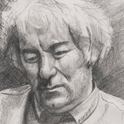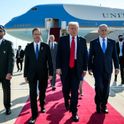The Conquest of Siberia by Vasily Surikov, 1895: "Wars cannot bring peace without victory, and cannot be won by clever stratagems alone" © Fine Art Images/Superstock
Everyone knows that the purpose of war is to bring peace by ending deadly quarrels in one way or another. In his new book, Ian Morris explores the different ways in which this has been achieved across the millennia, drawing examples from the pre-prehistory of primate studies to the headlines of 2013, by way of archaeology (his profession) and plain historiography (his passion). Morris reprises the celebrated argument of the sociologist Norbert Elias that the “civilising process” is responsible for the decline in violence over recent centuries. My own belief is that nuclear weapons, and they alone, prevented a third world war during the Cold War years.
Morris, who is a professor of classics and archaeology at Stanford, starts by clearing away the delusion that peace could exist in the “state of nature”—that is, before the development of civil society or the political state. Before there were greedy military industries, bellicose professional soldiers or evil politicians to provoke periodic wars, there was instead the perpetual war of all against all. Many anthropologists have been reluctant to recognise the obvious—that tribespeople are warriors who like to keep in practice even when resources are not scarce.
That allows Morris to have fun debunking the peaceful-savage mythology popularised in the 20th century by Margaret Mead’s bestselling Coming of Age in Samoa (1928). The island Mead studied, Ta’u, had a higher crime rate than Detroit at its worst (at the time Mead was there, Ta’u was under US rule and had US law). Morris also nails the scandalous attempts to throw Napoleon A Chagnon out of academia for having recorded over many years the habitual violence of the Yanomamö tribe of the Amazon. (Chagnon was even accused of having made the Yanomamis violent all by himself, by giving them machetes.)
It takes an exceptionally unlucky or misgoverned state to do worse than tribal society in producing domestic peace, because the very existence of any state is delimited by its monopoly of force, but Morris rightly devotes greater attention to empires. They are the wholesale purveyors of the precious commodity—even if empires are first acquired by war, even if they continue to wage wars either to protect, or further expand, their frontiers. But that is precisely the point: instead of the war of all against all that exists in the state of nature, instead of the multitude of wars that a multitude of smaller states allows (as with the Rajas of pre-British India), empires exile war to their peripheries, thus allowing peace to exist within them. Indeed, there have been many post-imperial wars between former imperial subjects in the Middle East and beyond.
Empires, more than smaller states, need an entire ideological superstructure to legitimise their power. As a practicing archaeologist, however, Morris remains firmly focused on the material basis of empires—the extraction of resources by tax collectors. While the empires that Morris surveys range from the Assyrian to the American by way of the Mauryan, Han, Kushan and Tang, as well as the Roman, all the immense diversities between them are flattened by the same iron rules of resource extraction.
First, the imperial peace itself generates prosperity that allows revenues to increase over time, thus paying for more soldiers who can conquer more land for the empire, generating yet more taxable prosperity and so on and on. Indeed that is how empires happen.
But, second, empires are not nations that can endure no matter what unless exterminated or assimilated—they are tax-collecting, revenue-spending machines whose efficiency is always under attack. Often it is the very success of empires that is their undoing: the strong army that ensures the long peace becomes weak through inaction; hard-working, devoted officials who rose by merit alone earn such acclaim that their offices become hereditary; prosperity triggers competitive displays of wealth that cause officials to steal more from the treasury, and so on. And with imperial decay, the imperial peace decays too, by way of rising banditry, then looting raids from beyond the frontiers, then invasions that cannot be repelled any more. That is how it was for empire after empire, and no different for the Ming than for the Western Roman empire, which the East Roman empire outlasted by a millennium.
Morris adds up the benefits of imperial peace by quoting Cicero, loyal army majors and others, but he seeks numbers whenever possible to demonstrate mounting prosperity (for example, the number of shipwrecks as testimony to the rise of navigation).
Morris looks at the other side of the ledger too: the casualties inflicted by empire-conquering and empire-keeping. The Spanish, Portuguese, British, French, Belgian and Italians killed millions and the epidemic diseases they brought with them killed even more millions, before the survivors could begin to enjoy the long years of peace assured by the colonial empires. Yet Genghis Khan and his sons and grandsons, as also Mao and Stalin individually, probably killed more people than all the colonial empires combined in what Morris calls the “500 years war” of 1415-1914. During this period Europe almost conquered the world—only to give up its colonies because its own democracy undermined colonial rule.
War, imperial or not, cannot bring peace without victory, and wars cannot usually be won by clever stratagems alone (a persistent Chinese delusion responsible for countless defeats). They require both fighting strength and operational skill to win battles. Morris follows the eminent classicist and military historian Victor Davis Hanson in identifying a “western way of war,” which is distinguished by its ferocity in seeking decisive fights. This manner of fighting originated in pre-classical Greece, between 700 and 500 BC, with the head-on charges of armoured spearmen—the citizen-hoplitai, such as Socrates, who wanted to finish the fight as soon as possible to go back to Athens and philosophise some more. That was the tactic that shocked the Persians at Thermopylae in 480 BCE and Plataea the year after, especially when meeting the best-drilled Spartans.
This same manner of fighting would later shock the Aztecs and Inca, Siberian tribesmen, Mughal and Manchu when Spanish, Russian and British solders fought them in close combat. This was the straightforward reason for the tactical superiority of western forces in the five colonial centuries, which had to offset the logistical disadvantages of fighting very far from home. (Think of the Cossacks on the Amur River in the 17th century, 5,000 miles from Moscow, fighting against Manchu troops. At that time it would have taken at least 250 days to supply them with just one more musket.)
For good or ill, that western ferocity is still with us, and is manifest even in the mere skirmishes in places such as Mali. For what it is worth, it was our only advantage in my own only serious experience of war, in the 1960s. We sought the hand-to-hand fight, and the enemy tried to avoid it by flight.
But that kind of violence runs against the thesis—to which Morris subscribes—of Norbert Elias’s influential book The Civilising Process. “Since the Middle Ages,” writes Morris in summarising Elias’s argument, “upper-class European men (who had been responsible for the lion’s share of brutality) had gradually renounced the use of force, and the overall level of violence had declined.” Elias first published the book with very unfortunate timing in 1939, but in spite of the Second World War and the Holocaust, Morris deems Elias’s argument vindicated by post-1945 events, little wars notwithstanding (there was no Somme in Iraq or Afghanistan, no El Alamein either).
This is where I disagree with Morris: he attributes the decline of war to the civilising process, adducing other testimonies too, whereas I give the credit to the nuclear weapons that are too powerful to be useful, and thus inhibit all warfare between nuclear powers.
But this disagreement did not reduce my enjoyment in reading this book—which is something of a multimedia experience, with photographs, drawings, charts and maps. But it is the book’s elegantly succinct prose that will most captivate readers. It is a book filled with lucid explanations of the most recondite questions, with many revealing quotations and witty asides. Morris ends the book with one more paradox: “If we really want a world where war is good for absolutely nothing, we must recognise that war still has a part to play.”












